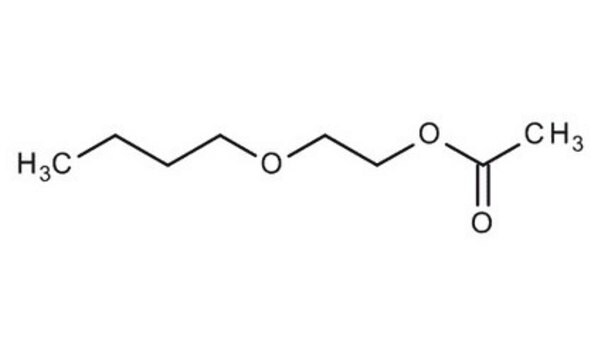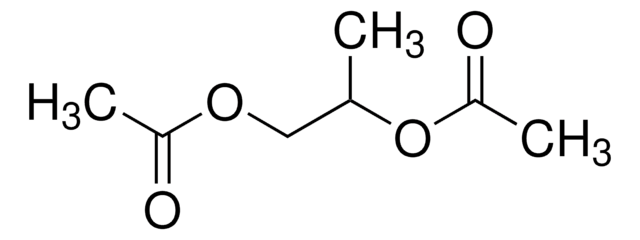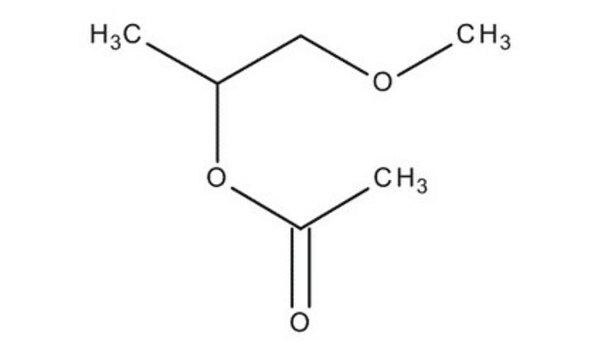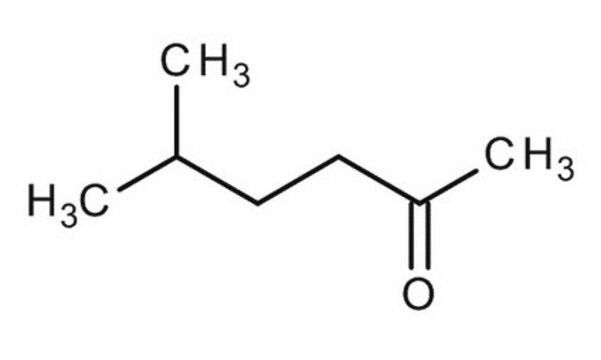307289
2-Butoxyethyl acetate
99%
Sinónimos:
1-Acetoxy-2-butoxyethane, BCA, Ethylene glycol monobutyl ether acetate
About This Item
Productos recomendados
densidad de vapor
5.5 (vs air)
Nivel de calidad
presión de vapor
0.29 mmHg ( 20 °C)
Ensayo
99%
Formulario
liquid
temp. de autoignición
644 °F
lim. expl.
0.88 %, 33 °F
8.54 %, 135 °F
índice de refracción
n20/D 1.413 (lit.)
bp
192 °C (lit.)
densidad
0.942 g/mL at 25 °C (lit.)
grupo funcional
ester
ether
cadena SMILES
CCCCOCCOC(C)=O
InChI
1S/C8H16O3/c1-3-4-5-10-6-7-11-8(2)9/h3-7H2,1-2H3
Clave InChI
NQBXSWAWVZHKBZ-UHFFFAOYSA-N
¿Está buscando productos similares? Visita Guía de comparación de productos
Categorías relacionadas
Descripción general
Aplicación
- Three-Dimensional Printing of Scaffolds: 2-Butoxyethyl acetate was utilized in the synthesis of poly(glycerol sebacate) acrylate for 3D printing applications, highlighting its role as a solvent in developing biocompatible materials for medical implants and tissue engineering (Wu et al., 2020).
- Migration Analysis in Food Contact Materials: Demonstrates the application of 2-Butoxyethyl acetate in the extraction and analysis of migrating compounds from plastic baby bottles, using GC-MS to ensure consumer safety and compliance with food safety regulations (Onghena et al., 2014).
Palabra de señalización
Warning
Frases de peligro
Consejos de prudencia
Clasificaciones de peligro
Acute Tox. 4 Dermal - Acute Tox. 4 Inhalation - Acute Tox. 4 Oral
Código de clase de almacenamiento
10 - Combustible liquids
Clase de riesgo para el agua (WGK)
WGK 1
Punto de inflamabilidad (°F)
168.8 °F - closed cup
Punto de inflamabilidad (°C)
76 °C - closed cup
Equipo de protección personal
Eyeshields, Faceshields, Gloves, type ABEK (EN14387) respirator filter
Elija entre una de las versiones más recientes:
¿Ya tiene este producto?
Encuentre la documentación para los productos que ha comprado recientemente en la Biblioteca de documentos.
Los clientes también vieron
Nuestro equipo de científicos tiene experiencia en todas las áreas de investigación: Ciencias de la vida, Ciencia de los materiales, Síntesis química, Cromatografía, Analítica y muchas otras.
Póngase en contacto con el Servicio técnico













